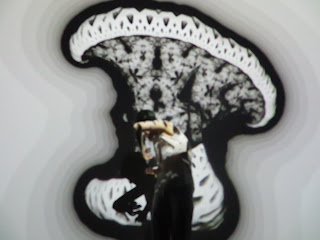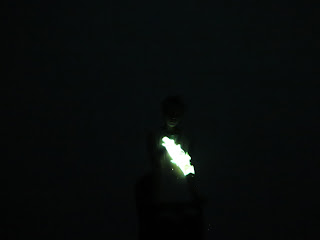An interactive dance performance in augmented visual and aural space:
The
DoD is part of an anthology of narratives called X_short_Stories, each of the “short stories” seemingly
self-contained and independent, is presented in a dynamic, improvisational
fashion, in a way that each story is contributing into the composition of a
larger emergent narrative. The aggregated perceived narrative form, is based on
common structural and morphological characteristics found in each separate
story, providing a loosely coherent narrative experience for the recipient to
interpret.
The DoD narrative is inspired by the Japanese Butoh
dance theater aesthetics. The story is inspired by taboo topics and grotesque
imagery relating to the body as defined by a recently acquired digital
presence. Questions interrogated are related to issues such as sexuality, death
etc.— as redefined in a digital world—, and investigate the sort of
understanding these embodied 'narratives' evoke in a conscious intelligence.
Conceptual
and phenomenological structures such space and place—augmented through
digitization—, alter 'structures' such memory, and the new construals, and
symbolic forms, affect inherent 'human' processes, such as dreaming, play and
interaction.
These
new forms (be it perceptive, cognitive or even symbolic) affect the
phenomenology of a perceived world, appearing as a continuum in the mind, but
in reality are the product of sampling and digital, fragmented information
arising from evolutionary shaped cognitive routines.
Human
narratives as appear in arts—even before new media—, are indeed a form of
digitization of the human experience. Reflected in narratives, even as
presented in art forms such as classical theater, is not the 'analog' version
(the continuum) of an experience or a story. Narratives in their essence are a
fragmentation of the actual story, a sampled (or even 'digital') version of it.
With
this in mind media based arts as found in the last thirty years do facilitate,
even in their most abstracted versions, a well equipped medium for complex
narratives.
In
this post-modern setting, the idea of identity has been replaced by that of becomings. Ontological thinking of
objects, and events can be considered now in terms of a dynamical
post-structural perspective. This ultimately affects the idea of human identity
and experience all together.
In
this reality the narratives are not self contained, rigid constructs but presuppose
the role of a recipient, which through cognitive metaphors, "connects the
dots", and forms the narrative in his/her mind. The idea of self as stable
form (the artist, the composer, the performer, the audience etc.), is only
valid at the fleeting instance of self realization, an 'empty' moment defined
always by fluid structures such as memory and expectations.
This
artwork approaches narrative in its purest manifestation, that of form and its
morphodynamics. In this way what is being narrated is independent of content,
and rather defined as continuous transformations, and evolutions of forms (be
it ideas, aural, visual or manifested through the movement of the body).
The
essence of this rhizomatic, dynamical approach to story and narrative, is the
presence of a they to translate the I which together the bring forth an
emergent we.
This
is reflected also in the technological character of these narratives that is
based on embodiment (the kernel of interpreting experience), immersion and augmentation
of the phenomenological reality.
The DoD, is a multichannel, immersive presentation of abstracted
narratives relating to taboo issues of human condition. Multichannel not only
in the sense of transmitted media (aural, visual etc.), but also in the sense
of multiple semiotic channels. The material used ranges from concrete to
abstract and tries to evoke in the recipient the notion that "narrative is
in the mind".
The
presentation in its current setup is designed for 38 audio channels (in various
immersive arrangements), and 3 projectors forming a CAVE structure. These
arrangements though are quite flexible and the presentation can be performed in
various formats (audio min requirements is 8 channels, and visuals are rendered
in any immersive arrangement, including dome, panoramic and 360 degrees
projections).
The
body of the performer is tracked in real time and the visuals are mapped to the
body of the performer and react to the performer's interaction with this
augmented version of space, place and story. Recorded motion captured
performances of other dancers are also part of the interactions in the
choreography, responding to the performers movement and establishing the
presence of digital bodies in the performance, with their own reactions, forms
and ultimately intelligence.
Furthermore
the software controlling the interactions between the different platforms and
collaborators is based on Rene Thom's catastrophe theory, a mathematical
modeling approach to describe form evolution in the phenomenological perceived
world. In this way the software design itself, is based on Thom's observations
on the structure of memory, dreaming, play, language and symbols.
Finally
the butoh choreography is an improvisational 'reaction' of the performer, based
on Thom's sixteen archetypal morphologies.
TECHNICAL DETAILS (RESEARCH AND DEVELOPMENT):
The images provided are not the finished performance but and R+D version of it with one projector. Final version to be presented in September. The development blog includes more technical details for the project, including videos, sounds, images of the R+D.
MOTION CAPTURE
Dancer Yu He Lin (Bonnie) was captured by 3 Kinect1 aligned cameras, and a Kinect2 (used mostly for dynamic shots). Skeleton data, and point clouds are used as material and control data for the real time performance. The digital presence of a performer, is portrayed as the shadow version of a performance that will-took place somewhere, at some point in time and space. Even though the actual 'physical' performance has been actualised the eminent digital version of it is residing in the virtual plane of infinite potentiality, only to be actualised again to a shadow Image of its nature at the time of the performance as something different.










































































































































































































































































































































































































































































































































































































































No comments:
Post a Comment